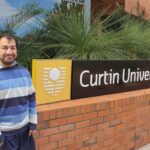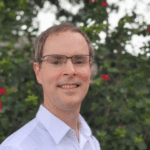At the age of ninety-two, Geoffrey Allen, Curtin’s founding librarian and an accomplished musician, could be forgiven for wanting to take it easy. But the British-born composer has no plans to slow down any time soon.
“I’ve never been someone to sit down and do nothing,” Allen laughs.
Passionate about music from a young age, he has composed, championed and published classical music for longer than most people have been alive.
Now eighteen of his piano sonatas will be recorded for the first time.
“The sonatas will be recorded later this month by pianist Murray Maclachlan at the Royal Northern College of Music in Manchester,” he smiles. “The first one dates back to 1958 and I finished the last one in April this year.”
Sixty years of musical output is extraordinary by any standard, but especially when considering Allen is self-taught. His music has been described by peers as “deceptively simple and extremely thought-provoking” and likened to Prokofiev, Tcherepnin and Barber.
“My objective is to write music that is both playable and interesting for the listener,” Allen explains.
“I’m not an avant-garde composer, I’m really a mid-twentieth century romantic composer, and basically English – with a touch of French, even though I’ve lived here most of my life.”
Born in England in 1927, he took piano lessons for several years as a child. But as a teenager, his passion for music was hampered by war.
“I was living twenty miles outside of London,” he recalls. “We weren’t seriously impacted by bombing, but the war meant you were stuck at home. There was no live music and I relied on the BBC for my listening.”
“I only heard two live performances as a teenager, at school and the local cinema, and I caught the music bug. I started off listening to Tchaikovsky and Grieg and Chopin, and jumped straight into Brahms, then Debussy and Delius, before moving on to contemporary composers of the day. Later in life, I became addicted to Mozart!”
Persuaded not to study music by his parents, who worried about dismal career prospects, Allen began a chemistry degree at Oxford University. But at the end of his first year, fellow students returned from the war, and he was sent on military service overseas.
It was during his service in post-war Singapore, that Allen’s eyes were opened to travel, and the possibility of living overseas.
“When I arrived in Singapore at Christmas in 1947, it was a revelation,” he exclaims. “It was completely different to England and made me realise I wanted to see the world.”
On his return to England, he switched to studying geography at Oxford, met his first wife and made plans to emigrate to Australia. He also wrote his first songs, three of which were performed at an Oxford University Music Society event.
The young graduate arrived in Sydney in 1952 and quickly found work teaching geography in the private sector. But when a position opened at the State Library, Allen leapt at the opportunity.
“I started off shelving books,” he remembers. “But I also worked in the adult education area where I met a New Zealander who was studying music with Edgar Bainton, the former director of the Sydney Conservatorium.”
Music was never far from Allen’s mind. He met with Bainton who convinced him of his musical talent and urged him to continue composing. But Allen would not return to serious composing for decades. His career as one of the country’s most renowned librarians – and his trailblazing foray into reader education and computer technology – were just beginning.
A brand new library
It was 1967, and after stints at CSIRO and the University of Western Australia (UWA), Allen was appointed Foundation Principal Librarian at the Western Australian Institute of Technology (WAIT), Curtin’s predecessor institution.

Before starting the job, Allen, and architect Vincent Davies, took a walk around the growing Bentley campus.
“Vin and I stood on the hill where the library was going to be, and we talked about how it should look,” Allen recalls.
“But the problem was nobody knew what WAIT would become, or how big it would be.”
Allen and Davies envisaged a campus with several thousand students and designed a large, mostly windowless (“for better light control”) multi-storey building. To many at the time, the library plans were ambitious, the building too big. Few imagined that one day the campus would be home to tens of thousands of students and staff.
Taking a sip of tea, Allen smiles wistfully as he remembers the challenges and fun of those early days.
“It’s most librarians’ dream to build their own library,” he says. “But not many people get the opportunity to do it.”
Named the TL Robertson Library, Allen would go on to lead the establishment for the next twenty-five years, championing major changes in reader education and computer literacy.
“The first time I went to a major library was as a student in Oxford – and I had no idea how it was organised,” he says. “Nobody taught me. I had to find out for myself.”

He realised the importance of teaching students and staff how to navigate the library and access its resources. He instigated compulsory “reader education” workshops (now known as information literacy) for all first-year students.
“I travelled overseas in 1969 looking for examples of reader education but I didn’t find very much,” he says.
“We were trailblazers.”
Allen’s pioneer program was a success. But he had no plans to rest on his laurels. It was the 1970s and new-fangled computer technology was attracting attention.
“I was first introduced to computers in the 1960s and I knew they were going to be important,” he says.
As a librarian at UWA, he was tasked with finding “some way to use a computer” to demonstrate its utility. He came up with the idea of writing a program to produce recall notices for overdue books.
“I figured that the notices would be a very visible way of using the computer!” he laughs. It took a few years of experimentation but the program was operating successfully by the time he left for WAIT in 1967.

In the early seventies, WAIT acquired its first computer and Allen negotiated with the Computer Centre for access to their new facilities. There had been many attempts to automate library activities but, possibly as a consequence of trying to create one comprehensive system, many had failed. Allen adopted a piecemeal approach.
“We decided not to write an entire system in one go,” he says. “First we created an acquisition system that was relatively straightforward, and then a circulation system and finally a cataloguing system. We used the same database with the idea that we would eventually combine them.”
By the late 1970s, the TL Robertson Library was one of the most automated libraries in the country.
The pace of technological growth matched the increasing size of the campus. In 1979, student enrolments at WAIT had risen from 4,500 to 12,000.
In 1987, the growing institute was renamed the Curtin University of Technology.

Today, the imposing TL Robertson Library rises high above the very same hill where Allen and Davies first discussed their vision. A focal point of Bentley’s busy and bustling campus, the library is open 24/7 and welcomes more than two million visitors a year. A significant project is underway to transform the historical building into a modern-day space for creativity and collaboration, further enhancing its benefits to students and the wider community (see artist impression).
A musical renaissance
The 1970s were a time of rapid growth for the library, but a difficult decade for Allen personally, who suffered the breakdown of his first marriage. There was little time for music.
But by the late ’80s, the head librarian had re-married and was enjoying a period of relative stability and calm.

Excited to learn that an upcoming Curtin conference would conclude with a concert, Allen offered to write some music for the event. The result was his Watercolours Suite for flute and piano. Sadly, the concert failed to eventuate, but the suite was later premiered in the library’s new lecture room and recorded by Curtin FM.
In 1989, a trip to Spain also reignited Allen’s passion for composition.
“I’d never been to Spain before,” he shares. “As my wife and I travelled through the country on a tour bus, listening to dismal stories of Spain’s bloody past, I was really moved.”
Allen returned to Perth and wrote a long piano sonata, characterised by Spanish harmonies and rhythms.
“It was the first really big thing I wrote,” he explains.
Allen’s resurfacing passion coincided with the emergence of music software for computers. He purchased the software and taught himself to produce printed sheet music. By the time he retired from Curtin in 1992, he had become proficient at producing and printing music and launched his own publishing company, The Keys Press.
“I bought a photocopier and built up quite a clientele in the years that followed,” he says.
“For a while, I was the leading publisher of classical music in Australia!”
In 2014, having published more than 500 classical works over twenty years, Allen gave away the business to focus on his own music.
“I’m very happy that it’s all coming together,” he beams. “I hope more people will discover my music now.”
The Geoffrey Allen sonatas will be released on two double albums next year by Divine Art recordings.



